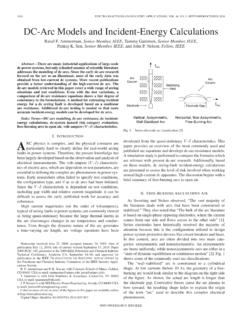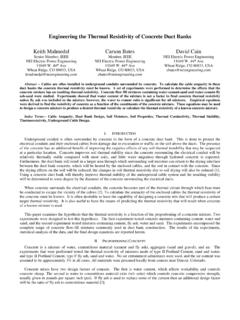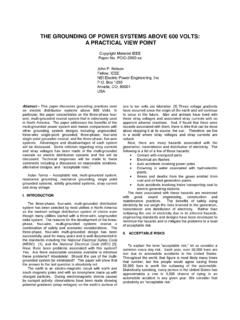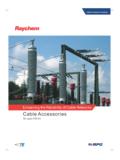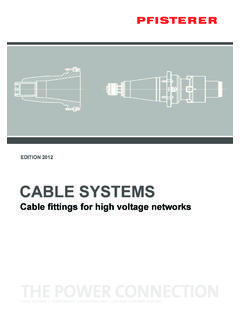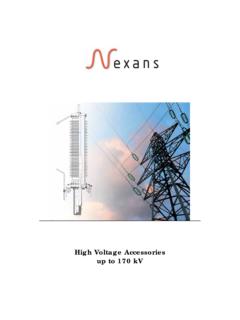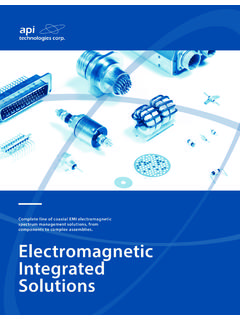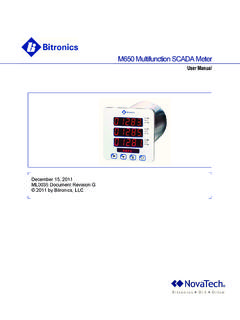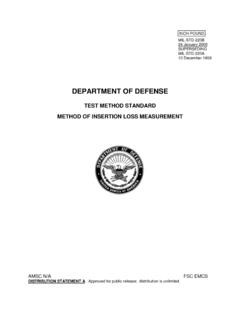Transcription of SOME LESSONS LEARNED FROM …
1 1 SOME LESSONS LEARNED FROM COMMISSIONING SUBSTATION AND MEDIUM VOLTAGE SWITCHGEAR EQUIPMENT Copyright Material IEEE Paper No. PCIC-2000-XX Andrew R. Leoni John P. Nelson Member, IEEE Fellow, IEEE NEI Electric Power Engineering, Inc. NEI Electric Power Engineering, Inc. Box 1265 Box 1265 Arvada, CO 80001 Arvada, CO 80001 Abstract - This paper presents some general procedures for the proper inspection, testing, and start-up of critical, but often overlooked, electrical items in substations and medium voltage switchgear commonly found in petro-chemical facilities.
2 The paper emphasizes procedures for protective relay and circuit breaker control circuit testing. Practical methods for testing current and potential circuits, which are the critical sensing inputs for most protective relaying, are discussed. Recommendations are made for confirming control circuits to ensure that protective equipment operates as intended. Finally, examples of common commissioning oversights are presented to emphasize the thoroughness needed to avoid potentially damaging consequences.
3 Index Terms Commissioning, Start-up, Medium Voltage Switchgear, Protection Circuits I. INTRODUCTION Over the course of an average day, somewhere in the world a major electrical failure occurs at a petro-chemical plant. For many outages due to corrosion, heat build-up, insulation failures (some accelerated by contamination or humidity), animals, improperly prepared terminations, or mis-operation, the cause is quickly identified and corrected, and the equipment is placed back in service.
4 With properly designed, installed, and maintained protection systems, damage is usually limited in scope. However, in cases with extensive and possibly collateral damage, the cause may not be found until a thorough analysis and investigation is complete. Unfortunately, the conclusion is never appealing. Often, the equipment or system: !"was designed incorrectly, !"was installed incorrectly, or !"did not perform as designed. Furthermore, the cause of many failures is either inconclusive or misdiagnosed.
5 For those instances when the system did not perform as designed, there are two common causes: !"Lack of maintenance !"Improper commissioning Commissioning a substation or medium voltage switchgear line-up both safely and on schedule requires significant planning, documentation, and effort, as discussed by Bowen in [1]. Most new switchgear is assembled and tested in the factory. However, some equipment suppliers may claim to test the switchgear but in fact may not truly perform comprehensive testing.
6 The switchgear is disassembled for shipment, and then reassembled at the job site. The result may be the creation of many mechanical and electrical problems. Start-up lists and test procedures, including IEEE standards [2] [3] [5] [6], testing organization procedures, electric utility procedures, and equipment manufacturer guidelines, exist to help discover these problems. However, many times the electric system was designed correctly, constructed with the best intentions, but not thoroughly inspected and tested by qualified personnel before being placed in service.
7 This paper is not a complete treatise on the subject of testing and inspection required prior to or after energizing medium voltage switchgear and substation equipment. It does, however, discuss many important aspects of ensuring the protection systems for substation or medium voltage switchgear are, from an electrical standpoint, ready to be placed in service. The following sections discuss: !"Important items to be considered in the commissioning planning stage !"Practical methods for checking protective device circuits !
8 "Common commissioning oversights and avoiding them II. COMMISSIONING AND START-UP Commissioning planning begins in the design stage. It should form a part of the specifications for the equipment purchased and installed, and must address the electrical and mechanical aspects of the installation. During procurement, careful review of submitted drawings and bills of material will help avoid conflicts in the field. The start-up process provides one of the final opportunities to review compliance with specifications and drawings.
9 The test results form a baseline on the initial condition of the equipment. The process should ensure the equipment: !"is assembled and connected correctly, !"has the proper ratings, !"has devices which are calibrated, and !"the overall system will perform as designed. Due to the complexity of modern protective relay systems, as discussed in [4], and the number of parties involved, the potential for errors and omissions must be accounted for in the planning stage. 2 For any given job, the equipment supplier, a separate testing group, the receiving organization, the design engineer, and/or end customer may provide start-up services.
10 In all cases, a competent authority should review the test results, conduct a final inspection, and perform system tests. This review ensures that the individual systems, proven by others to be correctly installed, will in fact work together as intended. Some of these tests and inspections occur before energization and others after load has been placed on the new equipment. Improper testing and start-up may jeopardize the reliability of the equipment, the process, and the safety of personnel.

